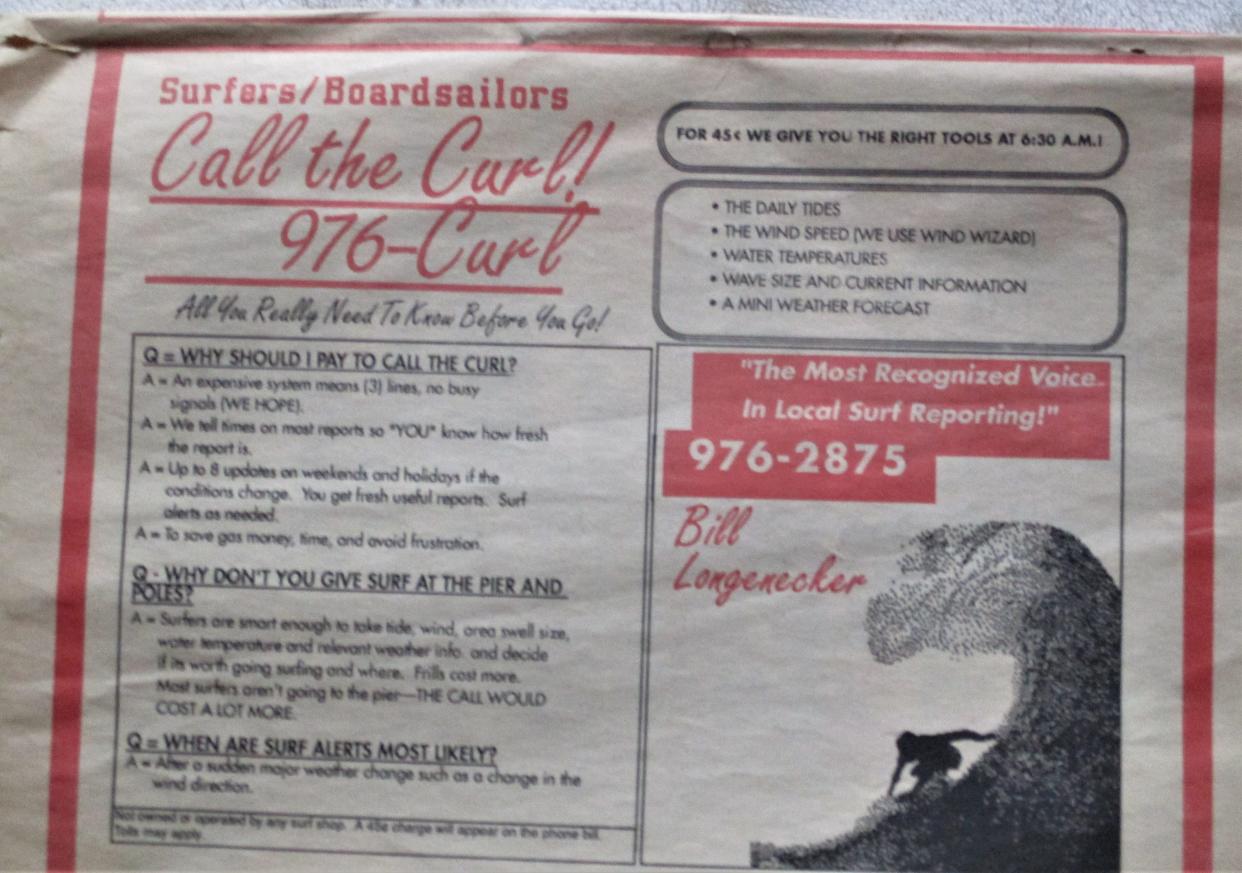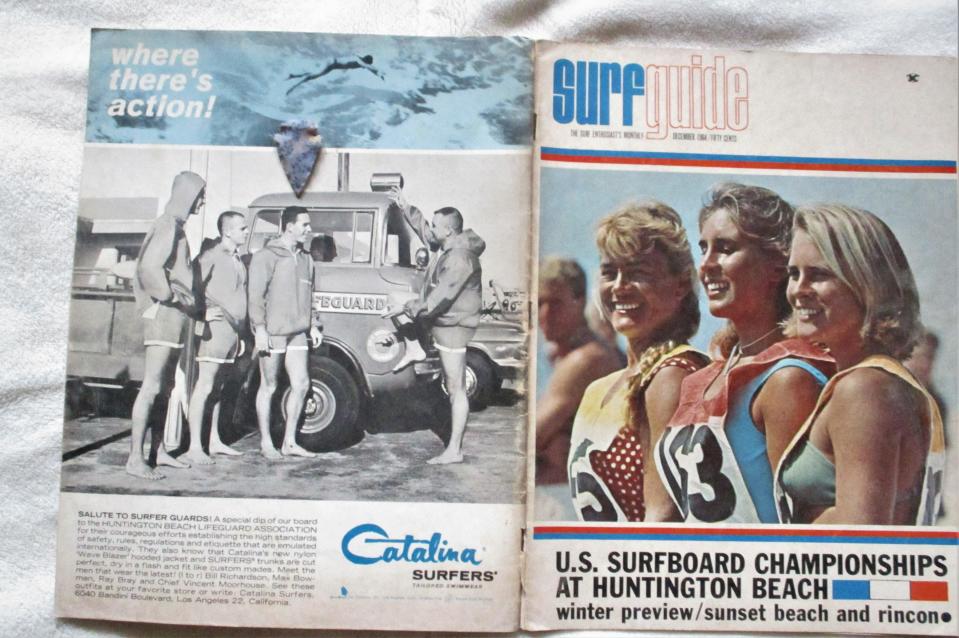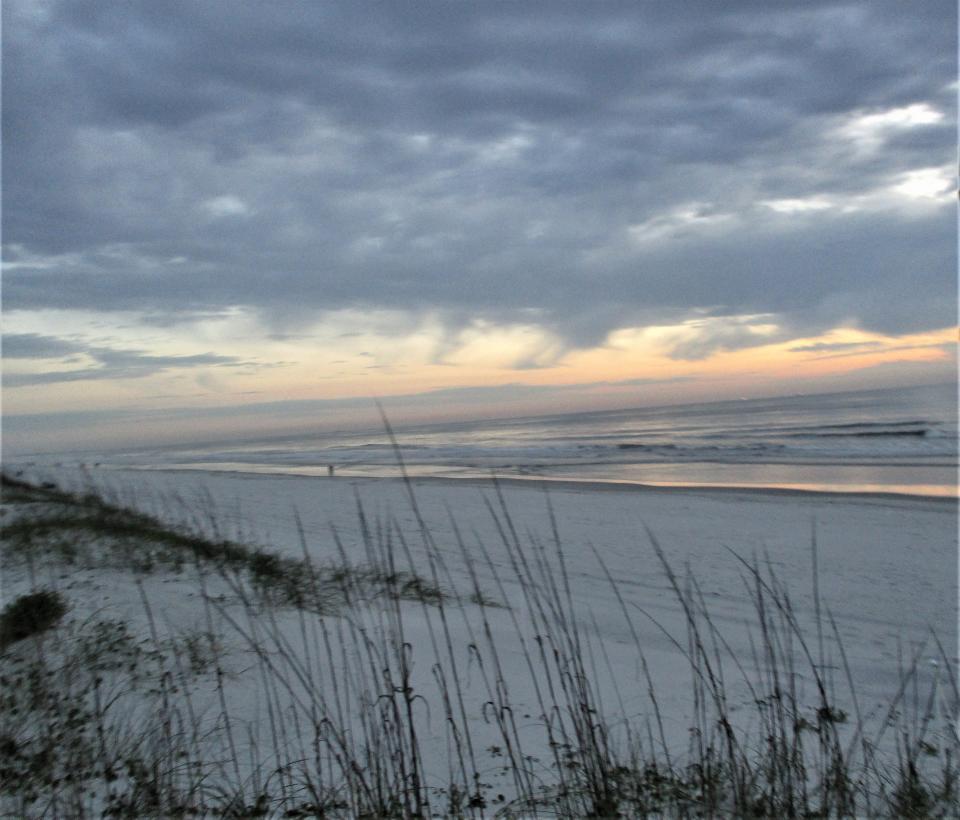Decades of 'phoning it in' come to a close as Bill's surf report hangs up for good

What began 38 years ago ended Saturday.
In the spring of 1984, Bill Hixon (of the famous Hixon’s Surf Shop) asked “Would you like to make money for doing what you do every day anyway?”
In other words, check the surf.
He offered me $50 a month plus a shop credit to take over his phone surf report. He gave me his answering machine and had a phone line put into my apartment. In spring 1984, my version of the surf report began.
During my year-long stay in California after high school, I relied on the Huntington Beach lifeguards’ daily surf report (although I usually went surfing anyway, no matter what they said).
It often began with “This is Raymond Bray of the City of Huntington Beach Lifeguards with the surf report for (day and date) …” I used his model because he gave the tides, water temperature, wind speed and direction and surf conditions.
More: Hixon's Surf Shop was a Neptune Beach institution
More: Here comes the sun ... and a former mayor with her camera
We had 15-, 30- and 45-second tapes to use depending upon the actual conditions. My goal has always been to be online by 6:30 a.m. so callers could decide what to do with their morning. A quick surf session before work or school, just go to work or school or call out from either due to “illness,” resulting from “Surf Alert” conditions.
Once in the late 1980s, I actually downplayed the incredible surf during an early September 6:30 a.m. edition. The waves had been pretty poor all summer. That morning, it was 4 to 8 feet, with perfect conditions. Fearing it might empty Fletcher High, I understated the report saying, “At least 3 to 5 feet and maybe larger sets.”
Just before I paddled back out, the 8:30 a.m. report said “Full surf alert 4 to 8 feet, light west winds high tide now, low tide 4:30. I know, I’ve been out!”
That last line became a signature ending when those situations occurred. Since I began reporting, I have tried to change the reports at least three times a day and often up to six or even 10 times as conditions changed. With only one line, busy signals were a common complaint. We burned out at least four machines between 1984 and 1990.
The best day came with Hurricane Hugo in September 1989. I put in the 15-second tape and simply declared “Full Surf Alert! Six to 10-foot-plus surf offshore winds. Repeated that, then added, “Hang up so others can call!”

Then, I was living on The Strand in Neptune Beach, a row of oceanfront houses back from the beach during the final days of Hixon’s Surf Shop.
One day, a 13-year-old boy called to me from his Strand oceanfront house, “How’s the surf?” I simply told him to go look out his window. I was that much of an “authority.” He could not trust his own opinion!
Hixon’s would close his shop in 1990 after 31 years. Just before that, I had his blessing to start a pay-for-call service on a 976 number. He let me do both reports. His line was in my living room and “Call the Curl” was in my dining area.
On Nov. 13, 1989, “Call the Curl” (976-Curl) began at 45 cents a call. I had three lines each hooked to a machine which rotated the calls. “Know Before You Go” and “Your Eyes on the Ocean” the mottos.
Four excellent young men helped when I could not personally be home to change the report. The first was Max Mozo. After Max left for college, Kevin Marasco became an actual employee. His brother Chris filled in too. John Miller, now a Marine Corps Lt. Colonel — who once piloted Marine One for President Obama — was 15 when he became a trusted surf reporter.

Forty-five cents a call did not meet my expenses. My first phone bill was almost $1,000. The price rose slowly until reaching 70 cent a call in 1996. It was still cheaper than driving to the beach for lousy surfing. We closed Hixon’s line down in 1990 as his shop was also winding down. I would sometimes hook my phone to the line and take calls live, much to the surprise of callers.
“Hello, thanks for calling this live edition of the Hixon surf report …” After stating the conditions, I would add “Any questions?” Most callers were so surprised they simply hung up! I took the last caller live. A sad moment.
During the summer of 1995, we enjoyed the best summer of surfing I have ever seen. Surf rarely dropped below two feet and generally ran 2 to 4 feet five days or so each week. My call monthly call totals for The Curl, were the highest ever. I never lost money, but it was merely an income supplement. It allowed me to purchase my first expensive mountain bike in 1991.
Cell phones and online beach cameras began to hurt my call totals, but fog was my friend. Cameras could not penetrate it, but I could swim out into the surf when necessary. There was not enough fog to offset that completion however.
Finally in November of 2000, after 12 years, I decided to end 976-Curl. I took that last call live as well. Another sad moment.
Then, a new light was lit. Dan Brooks of Sunrise Surf Shop took me on in December 2001. His call totals soared because he had unlimited lines through his phone company and callers knew my voice. No home machine was needed. Through a sophisticated system, I could call from anywhere and change the report by phone.
That situation often brought in more than 25,000 calls a month for several years. Sometimes, my reports were off because conditions changed before I could update the report. My conservative approach sometimes meant I might under call surf conditions. Some guys disagreed with my wave size.
About four years ago, the phone company changed its system. We went back to one line. Busy signals and more online services cut our call totals. Dan’s phone bill for his fax and surf line sharply increased. It far exceeded my salary and the totals dropped even more.
After 38 years, my surf reports have ended, for now at least. Dan is searching for a way to revive it. He has been so patient and such an excellent person to work with for many years.
Now, who will swim out into the fog?
Bill Longenecker is a Neptune Beach resident and longtime contributor to Shorelines. Send feedback to shorelines@jacksonville.com.
This article originally appeared on Florida Times-Union: WAVELENGTHS: Decades of 'phoning it in' come to a close

